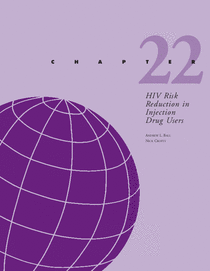General
 Hypochlorite (1%) is Inefficient in Decontaminating Blood Containing Hypodermic Needles
Harm Reduction - General
August 3, 2011
Hypochlorite (1%) is Inefficient in Decontaminating Blood Containing Hypodermic Needles
Harm Reduction - General
August 3, 2011
Infectious biomedical waste and sharps have a potential hazard of transmission of pathogens. Among sharps, used needles form a major share and disinfection by 1 % hypochlorite is recommended in biomedical waste management rules of India. The aim of the present study was to evaluate the efficacy of hypochlorite for the decontamination of needles.
 HIV Risk Reduction in Injection Drug Users
Harm Reduction - General
August 3, 2011
HIV Risk Reduction in Injection Drug Users
Harm Reduction - General
August 3, 2011
Infectious biomedical waste and sharps have a potential hazard of transmission of pathogens. Among sharps, used needles form a major share and disinfection by 1 % hypochlorite is recommended in biomedical waste management rules of India. The aim of the present study was to evaluate the efficacy of hypochlorite for the decontamination of needles.
 Plague Information for Veterinarians
Zoonotic Diseases - General
June 2, 2011
Plague Information for Veterinarians
Zoonotic Diseases - General
June 2, 2011
Plague is caused by Yersinia pestis, a gram-negative bacterium that is endemic to most of the western United States. Epizootics of plague occur in wild rodents (rock squirrels, prairie dogs, ground squirrels, chipmunks, wood rats, and others) and most people acquire plague by the bite of an infectious rodent flea.


